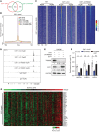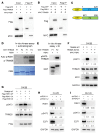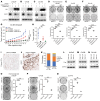RSK1-driven TRIM28/E2F1 feedback loop promotes castration-resistant prostate cancer progression
- PMID: 40519166
- PMCID: PMC12165809
- DOI: 10.1172/JCI185119
RSK1-driven TRIM28/E2F1 feedback loop promotes castration-resistant prostate cancer progression
Abstract
Castration-resistant prostate cancer (CRPC) marks the advanced and lethal stage of prostate cancer (PCa). TRIM28, also known as KAP1, is a transcriptional regulator recently shown to promote CRPC cell proliferation and xenograft tumor growth. Nonetheless, knowledge gaps persist regarding the mechanisms underlying TRIM28 upregulation in CRPC as well as the genomic targets regulated by TRIM28. Here, we report that TRIM28 is a E2F1 target in CRPC. Using an integrated genomic approach, we have demonstrated that TRIM28 forms a positive feedback loop to promote the transcriptional activation and genomic function of E2F1 independent of retinoblastoma (Rb) status. Furthermore, we identified RSK1 as a kinase that directly phosphorylates TRIM28 at S473, and, as such, RSK1 drives the TRIM28/E2F1 feedback loop. Accordingly, pS473-TRIM28 promotes CRPC progression, which is mitigated by RSK inhibition. In summary, our study reveals a critical role of the RSK1-TRIM28-E2F1 axis in CRPC progression, which may be exploited as a vulnerability in treating Rb-deficient CRPC.
Keywords: Cell biology; Endocrinology; Prostate cancer.
Conflict of interest statement
Figures







Similar articles
-
The prognostic and neuroendocrine implications of SLC25A29-mediated biomass signature in prostate cancer.Geroscience. 2025 Jun;47(3):4711-4732. doi: 10.1007/s11357-025-01538-4. Epub 2025 Jan 31. Geroscience. 2025. PMID: 39890746 Free PMC article.
-
Cyclin-dependent kinase 12 deficiency reprogrammes cellular metabolism to alleviate ferroptosis potential and promote the progression of castration-resistant prostate cancer.Clin Transl Med. 2024 May;14(5):e1678. doi: 10.1002/ctm2.1678. Clin Transl Med. 2024. PMID: 38736108 Free PMC article.
-
AURKB/CDC37 complex promotes clear cell renal cell carcinoma progression via phosphorylating MYC and constituting an AURKB/E2F1-positive feedforward loop.Cell Death Dis. 2024 Jun 18;15(6):427. doi: 10.1038/s41419-024-06827-y. Cell Death Dis. 2024. PMID: 38890303 Free PMC article.
-
Olaparib Monotherapy or in Combination with Abiraterone for the Treatment of Patients with Metastatic Castration-Resistant Prostate Cancer (mCRPC) and a BRCA Mutation.Target Oncol. 2025 May;20(3):445-466. doi: 10.1007/s11523-025-01146-4. Epub 2025 May 21. Target Oncol. 2025. PMID: 40397306 Free PMC article. Review.
-
Assessing the comparative effects of interventions in COPD: a tutorial on network meta-analysis for clinicians.Respir Res. 2024 Dec 21;25(1):438. doi: 10.1186/s12931-024-03056-x. Respir Res. 2024. PMID: 39709425 Free PMC article. Review.
References
-
- Nevins JR. Toward an understanding of the functional complexity of the E2F and retinoblastoma families. Cell Growth Differ. 1998;9(8):585–593. - PubMed
MeSH terms
Substances
Grants and funding
LinkOut - more resources
Full Text Sources
Miscellaneous

